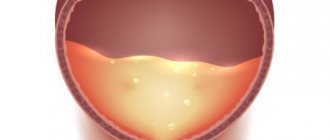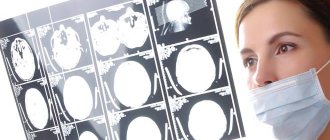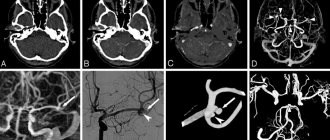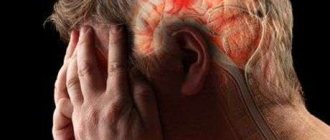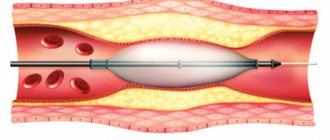Causes of vascular dementia
Dementia develops due to vascular changes in the brain. The most likely causes of the disease:
- suffered a stroke;
- blood clot formation;
- atherosclerosis;
- ischemic brain disease;
- heart defects;
- infectious diseases, vascular neurosyphilis.
Stroke is the most likely cause of the disease in older people (after 60 years). A stroke occurs as a result of the formation of blood clots that block blood vessels, or due to atherosclerosis. Dementia in this case appears due to oxygen starvation and lack of cell nutrition, which causes the death of certain groups of cells.
Cerebral ischemia provokes a decrease in the tone of small vessels, as a result of which the lumen between them narrows significantly, which causes the development of vascular dementia. Ischemia is often observed as a complication of decompensated diabetes mellitus in older age.
The risk group also includes people over the age of 65 whose diet does not have enough folic acid. In this case, the likelihood of developing dementia increases significantly.
Due to heart defects and diseases of the cardiovascular system, the blood supply to certain areas of the brain is disrupted. This causes oxygen starvation, which results in disruption of neural communication and death of neural tissue in the brain.
Thus, when talking about vascular dementia in older age, one should take into account a whole group of factors - atherosclerosis, stroke, chronic diseases and heart defects. The combination of these pathological conditions and processes in the body provokes the development of dementia.
In young people, vascular dementia can result from infection in the brain. The disease often occurs in patients with neurosyphilis.
Doctors know quite a lot of reasons why vascular dementia appears:
- profuse bleeding in the brain;
- slight hemorrhage;
- cardiovascular problems;
- persistent blood clots in the capillaries;
- immune pathologies, with damage to the walls of blood vessels.
Some factors contribute to the development of pathology. Dementia is much more common in older people over 60 and 70 years of age than in younger people.
The appearance of dementia is promoted by:
- heart rhythm failure;
- heart failure;
- heart disease;
- persistent blood pressure, above and below normal;
- diabetes;
- hereditary problems with blood vessels;
- unhealthy lifestyle, smoking, poor sleep, abuse of strong alcohol;
- obesity;
- sedentary type of work;
- inflammatory processes;
- frequent stress;
- hormone cortisol.
Causes that trigger the development of dementia
It is impossible to list all the causes that directly or indirectly lead to dementia.
The following factors most often underlie this condition.
- Hereditary predisposition.
- Cardiovascular diseases (arterial hypertension, coronary heart disease, atrial fibrillation, chronic heart failure).
- Endocrine disorders (diabetes mellitus).
- Conditions accompanied by oxygen starvation of the brain (smoking, anemia, changes in the wall of blood vessels in the brain), etc.
It is more clear to consider the causes of dementia based on the classifications of this condition existing in medicine.
Symptoms of vascular dementia
Vascular dementia is the abnormal functioning of the brain: lost memories, illogical thinking, lost orientation in space and time, meaningless speech. Signs do not appear in 1 day, but within six months. But there is vascular dementia with an acute onset, when a person loses his mind instantly, immediately after a stroke.
Subcortical vascular pathology is determined by the destruction of brain cells in deep parts of the brain. The cortex does not suffer at this time. More often, such problems occur against the background of persistent high blood pressure. The type of dementia is formed depending on what functions are controlled by the affected area of the white matter.
Subcortical syndrome often manifests itself as tremor and Parkinson's unsteady gait. The pathology lasts up to 20 years, in people aged 45-70 years.
In some cases, mixed cortical and subcortical vascular dementia occurs. Determined based on the clinical picture.
There is dementia, which begins from damage to neurons in the cortical areas of the brain.
In vascular dementia, there are three degrees of pathology: initial, moderate and severe. The degree of dementia is determined by the activity of the individual and his independence. Life expectancy largely depends on patient care. Moreover, death occurs not from the disease itself, but from an associated secondary infection, sepsis, double pneumonia, or bedsores.
Mild or early stage dementia is characterized by a clear limitation of professional skills and social life. Intelligence is not significantly impaired. The patient does not even notice any changes and remains completely independent.
The average degree is marked by a decrease in intelligence, memory and attention. Problems arise with independent living. There is a need for control by relatives. A person can still comb his hair if he is reminded how to do it. But he may accidentally injure himself when he is left alone in the kitchen.
In severe stages of the pathology, the patient cannot eat on his own, maintain basic hygiene, or get out of bed. At this time, motor functions and intelligence are impaired. A person stops recognizing his relatives and forgets himself.
In the first stage of dementia, relatives who notice that the person has become more inhibited and has lost interest in his favorite profession should definitely take him to the doctor. You should consult yourself about caring for the patient at different stages of the disease.
With a mild degree of dementia, relatives simply should not be offended by a person when his mood suddenly changes dramatically or his stinginess and pedantry worsen. That is, it is enough to show a little more love, forgiveness and understanding.
In the second stage, it is better to remove all sharp objects away. When the patient goes to the kitchen, you need to be nearby and protect him a little. The patient no longer needs to cut bread and peel potatoes. Do it yourself.
If your mother or elderly father has all the signs of severe dementia, independence is lost without a trace. The patient may lose control of natural bowel movements. It is necessary to provide the person with constant supervision. Diapers for adults and a hygienic diaper in bed help solve the most intimate problems.
An elderly person needs to be fed, changed, bathed, and combed. He himself is no longer capable of anything, no matter how sad it is. If all relatives work and there is no financial opportunity to hire a nurse, the patient must be placed in a medical institution, where he will be provided with professional care, timely nutrition, supervision and hygiene.
The first symptoms of vascular dementia are marked by an unexpected deterioration of individual character traits. A generous person suddenly becomes thrifty to the point of stinginess, turns into a real Plyushkin. A well-mannered person becomes rude, aggressive, harmful.
Over time, thinking ability slows down, forgetfulness, trembling limbs, and a slurred tongue appear.
Marasmus, which appears from damage to various lobes of the brain, is marked by a variety of symptoms:
- cell death in part of the midbrain leads to confusion. Subsequently, the patient becomes withdrawn, indifferent to everything, his appearance, friends and family;
- atrophy of neurons in the temporal lobes, characterized by loss of memories, up to complete amnesia. But first, recent memories fade;
- withering of cells in the frontal areas leads to apathy, idleness, and loss of desire to learn new things. Illogical actions begin, constant repetition of an already known phrase and movement;
- the death of subcortical neurons is marked by dissipation of attention, inability to concentrate on one thing. It is difficult for a person to analyze, separate the important from the unnecessary, and achieve success in his endeavors;
- if the pathology does not go away for a long time, cognitive degradation begins. In people with severe pathology, urination and bowel movements are not controlled;
- the mood is unstable, the emotional mood ends in depression. Self-confidence and an optimistic outlook on life are lost.
At-risk groups
The disease often develops against the background of a stroke. A recurrent stroke significantly increases the risk of dementia, but this depends on the amount of tissue affected and the area of the brain affected by the stroke.
To impair intellectual abilities, damage to a small number of neurons is sufficient. Any pathology that affects the cortex and subcortical region of the brain can cause the development of vascular dementia.
If other areas of the brain are affected, mental abilities are not affected, but loss of motor coordination may develop.
Dementia can result from impaired cerebral circulation, oxygen starvation and lack of nutrition to brain cells. All this is a consequence of ischemia and the presence of diseases of the cardiovascular system.
Patients with diabetes mellitus are also at risk. With constantly elevated sugar levels, the walls of blood vessels become thinner. This leads to disruption of the nutrition of brain cells.
Also, vascular dementia may appear due to constantly elevated concentrations of lipids in the blood.
The essence of the disease
The pathological process can be localized in the cortex, subcortical structures and other structures of the brain. This is what causes a whole range of possible manifestations of the disease. The extent of damage to brain tissue also influences manifestations. The causative factor that caused the disease should be taken into account.
The most typical clinical feature of the pathology is memory loss. It is quite possible that this will be the only manifestation of dementia within the framework of vascular brain damage. For this reason, the vascular form is often called dysmnestic dementia.
With other types of damage, the disease also affects other functions of the higher nervous activity of a person. Patients are diagnosed with impaired ability to create, learn and think abstractly. Severe dementia is accompanied by various variants of changes in the volitional sphere, emotional background, accentuation of certain features to the extent of caricature, grotesqueness.
As a result, the personality completely disintegrates until productive symptoms appear. Hallucinations and delusions may appear.
Causal factors
The disease predominantly develops in old age. But there are cases of diagnosis of dementia in able-bodied individuals.
It is necessary to identify etiological factors that independently affect brain tissue with the development of the described disease. These include the following conditions:
- Pick's disease (well known Pick's disease dementia).
- Progressive supranuclear palsy.
- Lewy body disease.
- Corticobasal degeneration.
- Alzheimer's disease.
The next group of reasons is associated with the progression of vascular diseases. Dementia after a stroke can develop either after a single cerebrovascular accident or after many similar episodes (the so-called multifocal condition).
It is known that stroke occurs both as ischemia (circulatory failure) and as hemorrhage (bleeding). Therefore, ischemic and hemorrhagic dementia are distinguished separately. Another variant of the disease associated with damage to the vascular bed of the brain develops in Binswaner disease. It is characterized by arteriolosclerosis - damage to small arteries. You can often find mixed forms of damage.
Other reasons
It is known that the disease accompanied by dementia can be caused by certain metabolic disorders. Thus, premature dementia develops with alcoholic illness as part of alcoholism. This is a rather severe form of mental pathology.
Psychosymptoms of dementia can be recorded in cases of impaired renal and liver function. Endocrinological pathology also affects the condition of the brain. This becomes obvious with dementia as part of the development of severe hypothyroidism and long-term diabetes mellitus with frequent hypoglycemic conditions. Micronutrient deficiency causes organic changes in brain tissue. Thus, dementia develops due to hypovitaminosis of B vitamins, for example.
Neurological diseases constitute a separate class of causes of dementia. There are many diseases that cause organic changes in the tissues of the cortex and subcortical structures of the brain. Dementia in Parkinson's disease is of a special nature. Mnestic disorders are less pronounced than neurological ones.
Neuroinfections (infectious diseases affecting the nervous system) lead to a condition such as early dementia. This is HIV- and AIDS-associated brain damage with the gradual development of dementia. Neurosyphilis stands apart - a late stage of syphilitic damage to the human body. The outcome of the disease is a psychoorganic syndrome with its manifestations. Other neurological conditions include Creutzfeldt-Jakob disease. It is associated with protein metabolism. It is caused not by viruses, but by prion particles.
Senile dementia
The body ages, all metabolic processes slow down, including the brain. Age-related changes in neuronal cells of the brain develop for various reasons. Even an infectious disease can become the impetus for the development of pathology.
Senile or senile dementia is a disease of older people. The following pathologies and diseases can trigger its development:
- obesity;
- kidney dysfunction;
- pathologies of the adrenal glands;
- Alzheimer's disease;
- immunodeficiency;
- malignant neoplasms.
The disease causes cognitive changes. This diagnosis is characterized by changes in thinking, memory impairment, problems with speech and concentration. The disease progresses very quickly, and literally after a couple of months the patient loses many skills and abilities, including professional knowledge.
Popularly, progressive age-related dementia is called senile insanity.
Causes
The course of vascular dementia and its severity largely depend on the cause of its occurrence and the general condition of the person. However, almost all people suffering from vascular dementia are characterized by symptoms such as deterioration of memory, thinking abilities, learning and general development.
This disease begins in different ways - for some it gradually, for others the acute form of the disease manifests itself immediately. However, it can be aggravated by various risk factors that can cause the destruction of brain cells.
The main causes of vascular dementia are considered to be:
- Various vascular diseases, such as heart attack or stroke.
- Tumors of the central nervous system.
- Viral encephalitis, AIDS, meningitis.
- Parkinson's disease.
- Alzheimer's disease.
- Kidney or liver failure.
Reference! Also, the cause of vascular dementia can be factors such as disorders in the endocrine system, alcoholism, hereditary predisposition, traumatic brain injury and other related factors.
Development of the disease
Depending on the location of the cell damage, dementia may have an acute onset. This form develops very rapidly, visible personal and emotional changes become noticeable very quickly. This rapid course of the disease is due to a stroke. After the first stroke, dementia develops within three months, but if the hemorrhage is repeated, mental impairment becomes noticeable a month after the stroke.
When the cerebral cortex is damaged, a multi-infarct form of dementia appears. The disease develops over four to six months and is accompanied by symptoms of ischemia.
As a rule, the disease is not limited to one area of the brain. If left untreated, dementia affects neighboring areas, resulting in mixed symptoms.
Diagnosis of the disease
The connection of cognitive deficit with a specific vascular accident, fluctuations in deficit in the presence of symptoms of focal neurological pathology allow us to make a diagnosis of vascular dementia.
Diagnostic criteria for vascular dementia include general signs of dementia, fluctuating cognitive impairment, acute onset, and/or stepwise progression. It is important to have neurological signs and symptoms indicating the lesion, as well as associated symptoms in the form of hypertension, carotid noise, emotional lability, and transient episodes of clouded consciousness. Variants of vascular dementia include acute-onset dementia, multi-infarct dementia, and subcortical dementia.
Differential diagnosis
Vascular dementia should be differentiated from dementia resulting from brain tumors and Alzheimer's disease. A brain tumor is accompanied by a longer period of general cerebral disorders, however, with metastasis, for example, a lung tumor to the brain, it is difficult to distinguish the combination of two disorders (tumor and stroke) from metastasis;
The only help at the first stage before an objective examination can be provided by anamnesis. Alzheimer's disease at the stage of amnestic disorders is not accompanied by such pronounced neurological disorders as vascular dementia; they appear later. However, sometimes acute dynamic disorders of cerebral circulation in the left hemisphere can lead to amnestic disorientation. The distinction is made on the basis of rheoencephalography, electroencephalography, and CT data.
Early diagnosis of vascular dementia provides a good chance of recovery. In difficult cases, timely diagnosis and proper treatment stop the progression of the disease.
Today, neurologists use modern research methods:
- lifestyle and chronic health problems are studied;
- a test is performed to detect cognitive degradation;
- blood pressure is controlled;
- the presence of sugar in the blood is determined;
- The percentage of lipids and cholesterol is determined.
The latest equipment is able to determine the exact location and extent of damage to neurons:
- radio examination;
- CT scan;
- Magnetic resonance imaging;
- electroencephalogram;
- ultrasound examination of the head;
- Dopplerography of blood vessels to determine the quality of blood circulation;
- x-ray of blood vessels;
- echocardiography.
The diagnosis is clarified after familiarization with the results of examinations, reflection and comparison of all known data.
Diagnostics
If vascular dementia was identified at the initial stage of development, then timely treatment gives the patient a chance for a full recovery and a normal life. If the pathology has already developed, then treatment can slow down this process. For diagnosis, the doctor needs:
- Study the history of the development of dementia and the characteristics of the patient’s life.
- Monitor blood pressure regularly.
Neurologist Alexey Valerievich Alekseev tells more about the specifics of diagnosing the disease:
- Conducting psychological testing, which allows us to identify various cognitive disorders.
- Regularly take a clinical blood test and monitor your sugar levels.
- Control of cholesterol and lipid levels in the blood.
Instrumental methods for diagnosing vascular dementia include:
- Radioisotope examination of the brain.
- Magnetic resonance or computed tomography.
- Ultrasound of the brain.
Echocardiography is an ultrasound method that diagnoses morphological and functional changes in the heart and its valve apparatus
- Electroencephalogram.
- Dopplerography of cerebral vessels.
- Echocardiography.
- Angiography.
The results of the studies make it possible to identify vascular dementia and begin its treatment.
Clinical picture
Dementia develops only in the presence of a provoking factor. To develop dementia, you must have a predisposition to vascular diseases. The disease is preceded by ischemic brain damage. This may be asymptomatic.
The development of dementia occurs in several stages. An acute onset of pathology is often noted.
At the initial stage, mild cognitive impairment develops. This stage is characterized by the following symptoms:
- sleep disorders;
- neurosis;
- attention disorder;
- sudden change of mood.
Once characteristic symptoms of personality changes or decreased intellectual abilities begin to appear, a diagnosis is made. This is the clinical stage of dementia. As a rule, the patient exhibits pronounced memory impairment, aggressiveness or lack of response to stimuli. Patients are subject to sudden mood swings.
This stage is characterized by the following symptoms:
- loss of orientation;
- memory losses;
- problems with movement coordination;
- aggressiveness.
Patients often have difficulty moving. Many are bedridden due to the inability to stand up on their own.
The last stage of a progressive disease is death. However, dementia itself is not fatal. The death is a consequence of a stroke, which occurs due to disruption of blood supply and nutrition to parts of the brain.
Prevention
To avoid becoming a patient suffering from vascular dementia, you should take care of the health of your blood vessels. Blood vessels are strengthened by contrasting douches and exercises in the fresh air.
Massage, outdoor games, football, tennis, gymnastics, swimming are good for the cardiovascular system. Sports walking along the paths of a pine grove, on the shores of the sea, lake, river, very well strengthens blood vessels, muscles, and immunity.
Those who do not want to waste many years recovering from a stroke should not develop bad habits. Smoking, gluttony, and drinking destroy healthy blood vessels.
An active, positive attitude, a keen interest in art, new technologies, literature, theater premieres, makes a person healthy and young even in old age. Active longevity is in fashion today! Stay fashionable and healthy, live longer!
Establishing diagnosis
Diagnosis of the disease is based on the manifestation of clinical symptoms in a particular patient.
To accurately determine the location of brain cell damage, examinations are necessary. Magnetic resonance imaging and computer examination of the brain are often prescribed for this purpose.
Diagnostic methods are necessary to determine the cause of brain tissue damage - heart attacks, cysts, cell damage. It is also necessary to conduct an electroencephalography of the brain.
Treatment of pathology
When talking about treating dementia, it should be understood that brain damage cannot be restored. Treatment is aimed at minimizing the manifestations of the disease and restoring intellectual abilities.
Drug therapy and treatment are necessary in order to minimize the patient's risk of stroke. This helps stop the progression of dementia.
Treatment includes:
- arterial hypertension therapy;
- treatment of atherosclerosis;
- getting rid of bad habits and excess weight;
- treatment of concomitant diseases;
- taking anticoagulants to prevent stroke;
- weakening of cognitive disorders.
Normalization of blood pressure should be carried out in such a way as to prevent its decrease and deterioration of blood circulation in the brain. Normalizing brain nutrition is the primary goal of drug treatment.
Therapy for atherosclerosis includes taking statin drugs, as well as following the necessary diet.
It is extremely important to stop smoking and drinking alcohol. These bad habits negatively affect the condition of blood vessels and blood supply to the brain and can cause rapid progression of the disease. An obese patient's weight is adjusted through diet.
Since dementia in older age can develop against the background of chronic diseases, such as diabetes, an important part of therapy is the treatment of concomitant diseases.
To avoid the development of dementia and limiting the patient’s ability to self-care, it is necessary to carry out appropriate therapy for neurological diseases. The drug Ginkgo Biloba is often prescribed to help treat cognitive disorders. As a rule, patients are prescribed various nootropic drugs and their analogues.
To improve the condition of blood vessels, a drug with an antioxidant effect is indicated. At an early stage of the disease, it is important to take the drug to improve blood supply to the brain.
Treatment
When choosing a treatment method, doctors first evaluate associated factors, such as hypertension, diabetes and others. Next, treatment is carried out with drugs that lower blood pressure and blood sugar levels.
Drugs
To activate intellectual abilities and the central nervous system, drugs with a neuroprotective spectrum of action are used.
Thrombolytics are also used to normalize blood clotting. It is recommended to quit smoking and adhere to a healthy lifestyle.
In addition to drug treatment, it is also necessary to fulfill the following conditions:
- moderate physical activity,
- patient care and care,
- compliance with the prescribed diet.
Important! It is impossible to isolate the patient from the rest of society; it is necessary to support his thinking abilities.
Hospitalization of a patient with vascular dementia may be necessary only if instrumental treatment is required or advanced cases of the disease require continuous monitoring.
